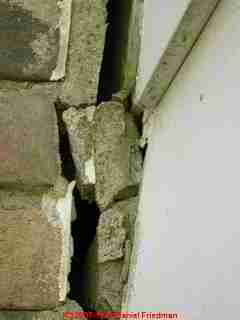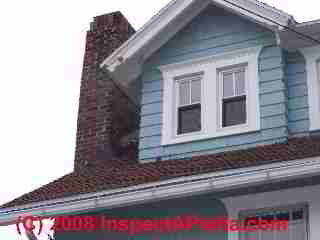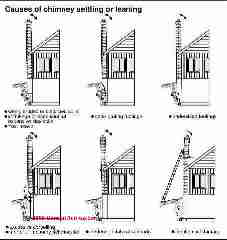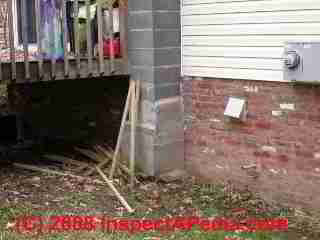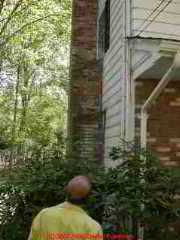 Ongoing Chimney Movement
Ongoing Chimney Movement
Leaning Chimney Evaluation
- POST a QUESTION or COMMENT about the cause, diagnosis, and repair of leaning, cracking, bending chimneys: chimney movement
Chimney leaning, cracking movement: diagnosing ongoing chimney movement:
This article describes chimney inspection procedures and critical chimney defects which can be observed from outdoors at ground level such as defective or missing chimney footing and evidence of continuing or ongoing chimney separation and movement away from a building. We outline common repair methods used to stabilize loose or leaning chimneys.
InspectAPedia tolerates no conflicts of interest. We have no relationship with advertisers, products, or services discussed at this website.
How to Detect Evidence of Ongoing Chimney Movement
Sometimes we see a chimney that has been "repaired" in this manner several times, with several generations of concrete or caulk or wood trim strips.
Our closeup photo above showed a wide concrete patch between a chimney and the building. Often we see thick build-up of roofing mastic where a chimney has moved at the edge of a building roof.
Our photo at left shows what looks like at least three generations of repair attempts at this chimney and four generations of chimney movement.
From left: white caulk, solid mortar mix, gray caulk. The open gap of about 1/2 inch shows serious continuing chimney movement.
[Click to enlarge any image]
This chimney is unsafe.
Our photos just below show clear evidence of major and recurrent chimney movement.
Above we see a build-up of roof cement where the chimney penetrates the roof structure.
At below left we see a wide metal strip which has been fabricated to cover the gap that has opened between the chimney and the building.
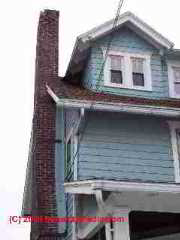
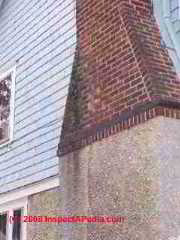
The chimney movement photographs presented here shows metal strapping used in a questionable attempt to stabilize the chimney by bolting it to the house gable-end wall.
You can see steel chimney strapping in the photos above.
A chimney with this much movement as well as any chimney with recurring movement almost certainly had an inadequate foundation or footing to start with. Strapping the chimney to the building is not going to work, the chimney is unsafe, and it probably needs to be torn down and replaced.
In some cases, however, if a chimney is intact it might be stabilized by any of several foundation jacking methods. We discuss this later
at CHIMNEY LEANING, REPAIR OPTIONS
Carson Dunlop Associates [at REVIEWERS] sketch shows six common causes of chimney movement. Understanding the cause of movement informs the choice of repair methods.
Other chimney movement gaps include caulk or even wood or metal flashing covering the gap between the chimney and the building.
If the chimney has recently moved, say since the last "repair" you will see a new gap or you may see a line on the chimney where a sealant that used to touch the building has torn away from the building but remained attached to the chimney side.
[Click to enlarge any image]
Such chimneys are unlikely to be safe, probably need major repairs, and are likely to need to be replaced entirely.
If we see a leaning or moving chimney that already has been re-lined we speculate that it may have been inspected and repaired but we'd still want to know just what was done.
If the chimney moved further after the liner was installed, connections between vented appliances or a woodstove and the chimney flue liner could have opened and thus might be unsafe.
Detecting a Missing or Inadequate Footing Support for Chimneys
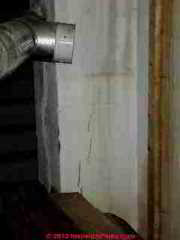
What happens if a chimney footing is missing or inadequate?
As we discussed earlier when looking at outdoor clues of chimney movement, masonry chimneys represent a heavy concentrated load on the soil or support structure.
Therefore, proper footing support is critical and is generally separated from the building footings except possibly at the exterior wall.
Our photo at left shows a diagonal, though nearly vertical, crack in a concrete block chimney. You should suspect that this chimney was built with an inadequate footing.
Splits in a chimney like this are very dangerous, risking flue gas leaks and fires. In extreme cases there is real risk of chimney collapse, as we discuss
at CHIMNEY COLLAPSE RISKS, REPAIRS
It should not come as a surprise that some masonry chimneys are constructed with an inadequate footing, or no supporting footing whatsoever.
Future settlement, movement, tipping, or separation of the chimney from the building is certainly likely in such installations.
Even a casual inspection from outside would raise the question about the absence of a footing for the chimney shown in our photo. You will notice the erosion of soil from below a little concrete skirt around the chimney base of this concrete block chimney.
On occasion you may find that the chimney was built on bedrock, taking advantage of a natural footing. Inspecting in a crawl space or basement where the bedrock is visible may reduce the anxiety of the inspector in such cases.
Homes built upon dry-laid stone foundations may have a chimney installed with its base sitting atop the foundation wall itself.
Those chimneys might be stable, but be sure to review our warnings about dead end flues
at DEAD END CHIMNEY FLUE HAZARDS
that are usually in use where such chimneys were built with no extension very far below ground level.
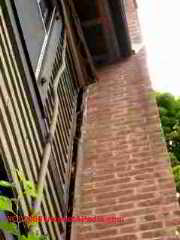
The photo at above left, courtesy of Arlene Puentes shows significant chimney separation from the building. Significant and costly repairs are needed to correct this dangerous condition.
A tipping chimney footing appeared to be the underlying cause of this significant and dangerous chimney movement.
We continue below with an explanation of the causes of chimney movement, followed by a demonstration of how we spot evidence that chimney movement has been ongoing. Other articles in this series outline most other chimney defects that can be found outdoors or indoors on buildings.
at CHIMNEY MOVEMENT CAUSES we explain the common causes of chimney cracking, separation, leaning, tipping, or collapse.
at CHIMNEY MOVEMENT, ONGOING vs STATIC we continue this article with a case reporting evidence of ongoing chimney movement, repeated repairs, and the need to remove and rebuild a large masonry chimney.
Reader Comments, Questions & Answers About The Article Above
Below you will find questions and answers previously posted on this page at its page bottom reader comment box.
Reader Q&A - also see RECOMMENDED ARTICLES & FAQs
Question:
(Oct 6, 2012) m.mitchell said:
WE have a 25 yr old house. the chimney is stucco and is cracked and really needs to be stripped of stucco and redone HELP! Is is just a matter of taking the stucco off ...and of course any other damaged sections inside?Is a brick & stucco chimney the same inside?
thank you,
(Nov 19, 2012) Robert Allman said:
Chimney seems to be straight only a partial 1/4 to 1/3 inch caulking separation visible? No space between chimney and ground around chimney. Could this be expansion and contraction of Aluminum siding. Some window replacement could be part of this causing separation.
Reply:
Possibly, Robert. But im never sure that a reader has put into a question all of the info i would have seen onsite, so to be safe why not sat a certified chimney sweep to check out the flue?
M Mitchell,
Stucco can be applied on all sorts of chimney constructions and is rather independent of the flue and of the structure itself. The key questions are the condition of the chimney structure and the safety of the flue.
But I agree that stucco, cracked or not, can cover something going on with the chimney itself. You may have to remove stucco to see the condition of the chimney structure. Start at the worst looking location. Don't forget to have the flue cleaned and inspected as well.
Question:
Re-posting lost comment:
Sam said: our chimney is bracketed to the house but the brackets are pulling away from the building. What's going on? Could the vertical weight of the chimney be the problem.
Reply:
Sam
Perhaps you could send me some photos (email is at CONTACT US) and I could understand this better.
Typically there is not a weight problem because intermediate brackets over the height of the metal chimney clamp around the metal chimney and are bolted to the structural wall of the building.
More likely the chimney lacks an adequate foundation or the brackets were bolted just to siding not to the structure.
...
Continue reading at CHIMNEY FOOTING DEFECTIVE / MISSING or select a topic from the closely-related articles below, or see the complete ARTICLE INDEX.
Or see these
Recommended Articles
- BRACING for MASONRY CHIMNEYS
- BRICK CHIMNEY CRACKS & COLLAPSE
- CHIMNEY COLLAPSE RISKS, REPAIRS
- CHIMNEY CRACK DETECTION & DIAGNOSIS
- CHIMNEY DAMAGE by LEAKS & FROST
- CHIMNEY FLUE INSPECTION CAMERA
- CHIMNEY INSPECTION DIAGNOSIS REPAIR - home
- CHIMNEY INSPECTION, FLUE INTERIOR
- CHIMNEY LEANING, SEPARATION, MOVEMENT
- CONCRETE BLOCK CHIMNEY CRACKS
- CURVED BRICK CHIMNEYS, SULPHATION
- SOIL PROPERTIES & BUILDING FAILURES
Suggested citation for this web page
CHIMNEY MOVEMENT, ONGOING vs STATIC at InspectApedia.com - online encyclopedia of building & environmental inspection, testing, diagnosis, repair, & problem prevention advice.
Or see this
INDEX to RELATED ARTICLES: ARTICLE INDEX to CHIMNEYS & FLUES
Or use the SEARCH BOX found below to Ask a Question or Search InspectApedia
Ask a Question or Search InspectApedia
Try the search box just below, or if you prefer, post a question or comment in the Comments box below and we will respond promptly.
Search the InspectApedia website
Note: appearance of your Comment below may be delayed: if your comment contains an image, photograph, web link, or text that looks to the software as if it might be a web link, your posting will appear after it has been approved by a moderator. Apologies for the delay.
Only one image can be added per comment but you can post as many comments, and therefore images, as you like.
You will not receive a notification when a response to your question has been posted.
Please bookmark this page to make it easy for you to check back for our response.
Our Comment Box is provided by Countable Web Productions countable.ca
Citations & References
In addition to any citations in the article above, a full list is available on request.
- Thanks to Luke Barnes for suggesting that we add text regarding the hazards of shared chimney flues. USMA - Sept. 2008.
- Uniform Mechanical Code - UMC 1991, Sec 913 (a.) Masonry Chimneys, refers to Chapters 23, 29, and 37 of the Building Code.
- New York 1984 Uniform Fire Prevention and Building Code, Article 10, Heating, Ventilating, and Air Conditioning Requirements
- New York 1979 Uniform Fire Prevention & Building Code, The "requirement" for 8" of solid masonry OR for use of a flue liner was listed in the One and Two Family Dwelling Code for New York, in 1979, in Chapter 9, Chimneys and Fireplaces, New York 1979 Building and Fire Prevention Code:
- "Top Ten Chimney (and related) Problems Encountered by One Chimney Sweep," Hudson Valley ASHI education seminar, 3 January 2000, contributed by Bob Hansen, ASHI
- Chimney Inspection Checklist, Carson Dunlop, Associates, Toronto, Ontario
- "Rooftop View Turns to Darkness," Martine Costello, Josh Kovner, New Haven Register, 12 May 1992 p. 11: Catherine Murphy was sunning on a building roof when a chimney collapsed; she fell into and was trapped inside the chimney until rescued by emergency workers.
- "Chimneys and Vents," Mark J. Reinmiller, P.E., ASHI Technical Journal, Vol. 1 No. 2 July 1991 p. 34-38.
- Our recommended books about building & mechanical systems design, inspection, problem diagnosis, and repair, and about indoor environment and IAQ testing, diagnosis, and cleanup are at the InspectAPedia Bookstore. Also see our Book Reviews - InspectAPedia.
- National Chimney Sweep Guild - Yellow Pages of Suppliers
- In addition to citations & references found in this article, see the research citations given at the end of the related articles found at our suggested
CONTINUE READING or RECOMMENDED ARTICLES.
- Carson, Dunlop & Associates Ltd., 120 Carlton Street Suite 407, Toronto ON M5A 4K2. Tel: (416) 964-9415 1-800-268-7070 Email: info@carsondunlop.com. Alan Carson is a past president of ASHI, the American Society of Home Inspectors.
Thanks to Alan Carson and Bob Dunlop, for permission for InspectAPedia to use text excerpts from The HOME REFERENCE BOOK - the Encyclopedia of Homes and to use illustrations from The ILLUSTRATED HOME .
Carson Dunlop Associates provides extensive home inspection education and report writing material. In gratitude we provide links to tsome Carson Dunlop Associates products and services.


